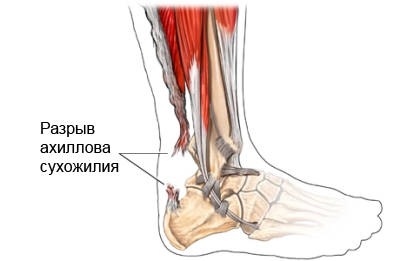Rupture of the Achilles tendon – Achilles tendon rupture
Description Achilles tendon rupture
Achilles tendon connects the calf muscles to the heel bone. Gap, or tear can occur, Esslin tendon peregruzheno. This injury is very painful. When the tendon is torn, You can hear the noise or click.

Causes of Achilles tendon rupture
Achilles tendon rupture can be caused by:
Too much load on the tendon during:
- Races, but especially the hills, ladders, and hard coatings;
- During jumps, twists (eg, in the game of basketball, football, rugby).
- The weakening of the tendon, is not fully recovered from a previous injury.
- Inflammation of the tendon;
- For injuries, when the tendon is cut or damaged.
Risk factors for an Achilles tendon rupture
Factors, which increase the likelihood of an Achilles tendon rupture include:
- The presence of weak or inflexible calf muscles;
- Excess weight;
- Wearing uncomfortable shoes;
- The presence of flat feet;
- The lack of warm-up before doing exercise or playing sports;
- Crick;
- Sport games, such as basketball, football, rugby;
- Using relaxing drugs, that help reduce pain and may lead to excessive stretching of the tendon;
- The presence of an earlier Achilles tendon rupture;
- The use of quinolone antibiotics or corticosteroids, which can weaken tendons;
- Vascular disease (eg, rheumatoid arthritis, lupus erythematosus, scleroderma);
- Smoking.
Symptoms of Achilles tendon rupture
If any of these symptoms, it is not necessarily caused by rupture of the Achilles tendon. These symptoms may be caused by other factors.
- When injury occurs-clicking or snapping noise;
- Sudden, severe pain in the back of the heel;
- Swelling in the heel (severe injury with a complete rupture of the tendon);
- Failure to build on the injured leg;
- Failure to keep the injured leg.
Diagnostics
Doctor, probably, able to make a diagnosis on the basis of visual inspection. If the symptoms are not well understood, may require additional inspection:
- MRT – test, which uses magnetic waves, to make pictures of structures in the body; used in the examination of the tendons and joints;
- Ultrasonography;
- Test Thompson – a method to test the tendon compressing the calf muscles;
- X-ray – test, which uses X-rays, to take a picture of structures inside the body, especially bones.
Treatment
Treatment options include the following:
First aid
For first aid after the injury must be:
- Immediately sit down or lie down;
- Attach to the site of injury, ice or a cold compress;
- Apply to the injury fixing bandage;
- To reduce pain and swelling, you need to raise your legs.
Medication
To reduce the pain and swelling should take the following medications:
Nonsteroidal anti-inflammatory drugs (NSAIDs), such as:
- Acetaminophen;
- Ibuprofen.
Surgical intervention
Surgery is the most common way to treat an Achilles tendon rupture. The doctor makes an incision in the lower leg. The tendons are stitched together. In place of operation closed with stitches, bus, which are worn over 6-8 weeks, until complete healing. One advantage is that the operation, that it reduces the risk of re-rupture of the tendon. Surgery may be the best option, if the victim is engaged in sports.
Nonsurgical care
Another option is to treat the tendon without surgery. In this case, you must wear a plaster, bandage during 6-8 weeks. This treatment takes longer, than surgery. To warm up, you can do a variety of light exercise. If there are contraindications, or chronic disease, which prevents operation, a preferred method of treatment.
Recovering from injuries
During recovery, necessary:
- Perform light physical urazhneniya;
- Use the device to support the body (eg, a walker or crutches).
Most people can return to normal activities within 4-6 months.
Prevention
To reduce the risk of rupture of the Achilles tendon, you must take the following steps:
- Warm up before doing exercises;
- Wear comfortable shoes;
- Stretch the muscles before sporting activities;
- Maintain a healthy weight;
- Relax, If there is pain during physical activity. Avoid actions, that cause pain;
- Switching from active work (eg, run) the more relaxed (eg, walking);
- We need to do the exercises, which strengthens the calf muscles.
These recommendations can also reduce the risk of re-injury.
